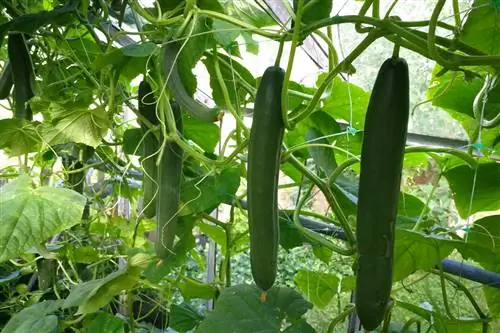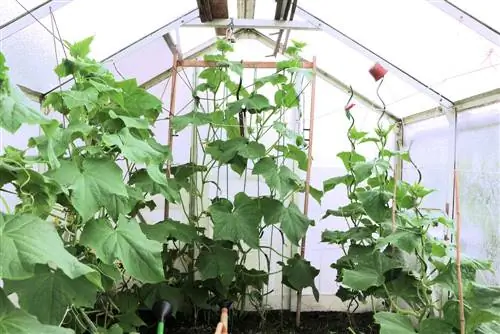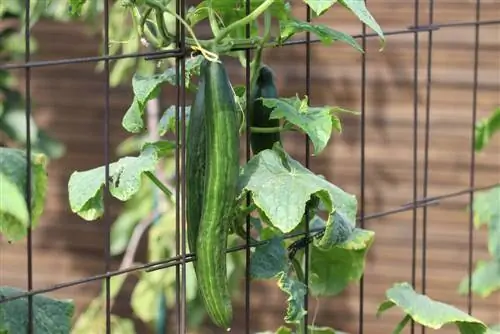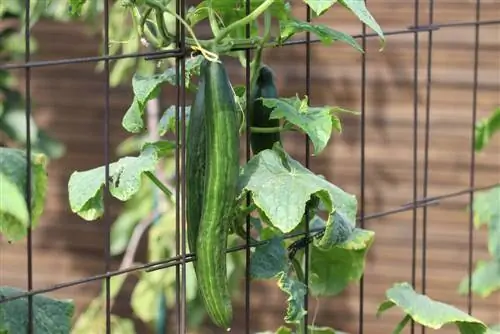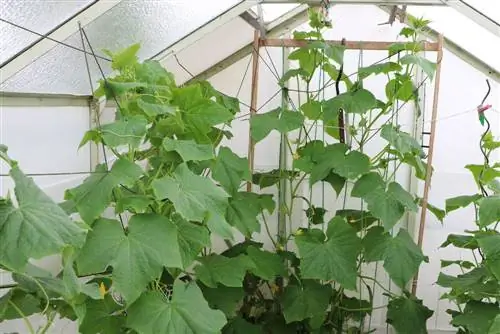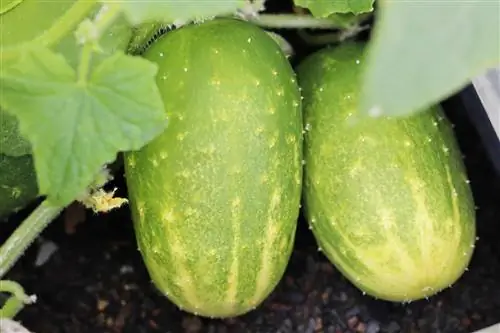- Author admin [email protected].
- Public 2023-12-17 03:39.
- Last modified 2025-01-24 12:45.
The garden cucumber thrives on humus-rich and loose soil. It prefers a warm, humid climate and values rapid soil warming in spring. Mixed crops are recommended for improved crop yields.
Vegetables and salad
Ideal planting partners for Cucumis sativus are vegetables that do not compete with each other. The following crops prove particularly good in a mixed culture because they come from other families. They ensure a varied harvest throughout the entire season.
French bean (Phaseolus vulgaris)
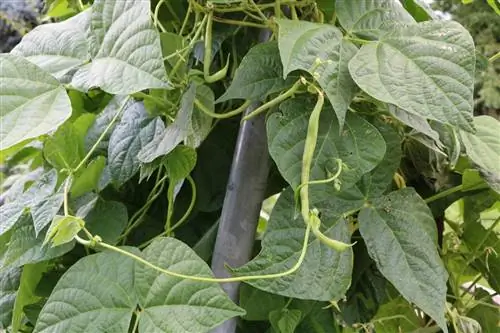
- Common names: pole or bush bean
- Advantage: are considered diligent nitrogen collectors, so cucumbers grow better
- Sowing: mid-May to the end of June directly outdoors
- Soil: deep, rich in humus and well loosened
- Location: warm and sheltered from the wind, preferably sunny
- Requirements: Beans value good water supply, no fertilizer necessary
- Care: Hill up soil and avoid waterlogging
Peas (Pisum sativum)

- Common names: garden or sweet pea
- Advantage: fix nitrogen in the soil, so that cucumber plants benefit
- Sowing: sugar peas from the beginning of April, sow more robust pale peas in the bed earlier
- Soil: humus-rich and fine-crumbly substrate
- Location: open and often sunny
- Requirements: uniform moisture from the moment the flowers form increases the harvest yield
- Care: Chop soil regularly, mulch and hill up soil after the first two weeks
Carrots (Daucus carota)
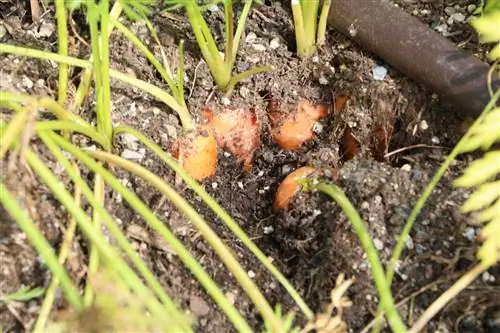
- Sowing: early and summer carrots from March in the cold frame, storage carrots from mid-May
- Soil: can be both sandy and heavy, avoid compost, preferably stone-free
- Location: warm and sunny
- Requirements: moderate but consistently high water requirement
- Care: Loosen the substrate regularly, pile up any heads sticking out
Tip:
The selection of carrot varieties is diverse. Depending on individual preferences, both fast-growing ball carrots and slow-growing finger carrots are suitable for a mixed culture with cucumbers.
Bulb fennel (Foeniculum vulgare var. azoricum)
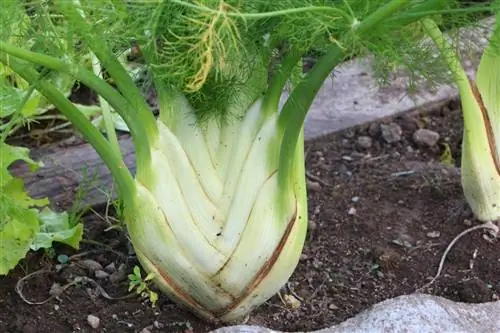
- Common names: vegetable fennel
- Cultivation: grow on the windowsill from January
- Soil: well-drained and rich in humus, calcareous
- Location: protected and sunny, warm climate ensures he althy growth
- Requirements: uniform supply of water and nutrients
- Care: Hill up plants two weeks before harvest
Lettuce (Lactuca sativa var. capitata)
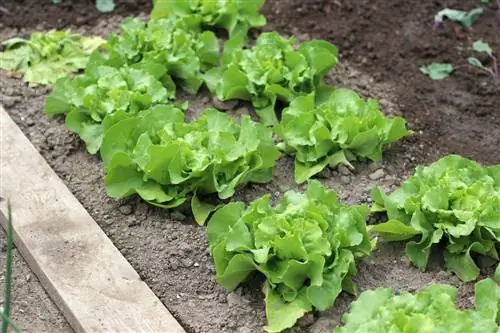
- Sowing: from the end of January in the cold frame
- Soil: deep and humus-rich substrate
- Location: preferably full sun
- Requirements: regular watering ensures fresh leaves
- Care: Chop and mulch the soil regularly during cultivation
Leek (Allium porrum)
- Common names: leek
- Advantage: tolerates heat and cold
- Sowing: prefer on the windowsill from January
- Soil: rich in nutrients and humus, preferably deep
- Location: thrives in both sunny and partially shaded locations
- Requirements: continuous medium water requirement
- Care: Chop the beds more often and pile up the stems
Spice plants
Some culinary herbs that also thrive outdoors have no problem with cucumber plants as neighbors. The intense scents of the spice plants not only enrich the menu, but also have positive effects on plant growth.
Basil (Ocimum basilicum)
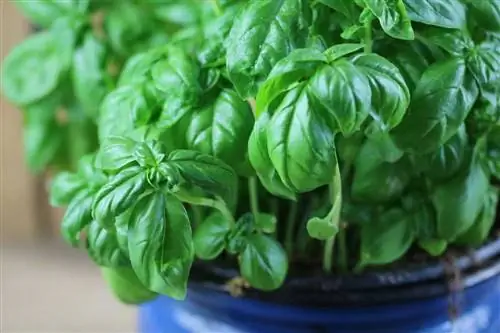
- Advantage: prevents mildew infestation
- Sowing: directly outdoors from the end of April
- Soil: prefers substrate rich in nutrients and humus
- Location: preferably sunny
- Requirements: requires sufficiently moist soil
- Care: shorten stems regularly to form shoots
Dill (Anethum graveolens)

- Sowing: from April in the garden
- Soil: medium heavy, grows well in poor soils
- Location: sheltered in a sunny to partially shaded location
- Requirements: low nutrient requirements, requires consistent moisture
- Care: Loosen the substrate occasionally
Caraway (Carum carvi)
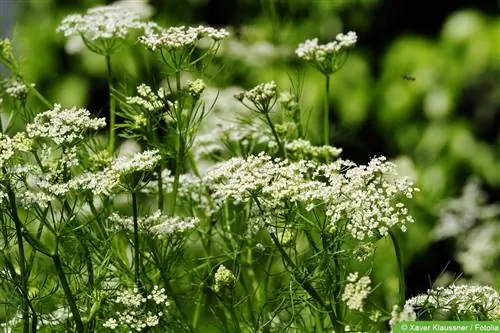
- Sowing: directly into the bed from April
- Soil: deep and nutrient-rich, well loosened
- Location: thrives in sunny to partially shaded locations
- Requirements: prefers moist but not waterlogged conditions
- Care: regular watering and soil loosening
Parsley (Petroselinum crispum)
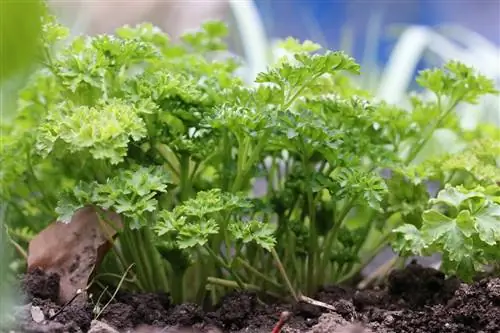
- Sowing: possible outdoors from mid-March
- Soil: permeable, deep and humic
- Location: prefers sunny to semi-shady locations
- Demands: high water requirement, cannot tolerate waterlogging
- Care: Add compost before sowing, chop regularly during cultivation
Flowering ornamental plants
Cucumber plants fit perfectly into an ornamental herbaceous bed. Some flowering plants are well suited to cultivation with Cucumis sativus due to their similar care and location requirements. Such plantings fit into garden areas that need a little more color and are intended to attract attention.
Tip:
Cucumbers also thrive when mixed with marigolds. These ensure improved pollination of the flowers as they attract beetles.
Sunflowers (Helianthus annuus)

- Advantage: provides support for cucumber shoots
- Sowing: outdoors only after mid-May
- Soil: nutrient-rich substrate, improve with compost
- Location: full sun and warm, no wind
- Demands: high and consistent water requirement
- Care: Avoid dry periods, support stems
Student flowers (Tagetes hybrid)
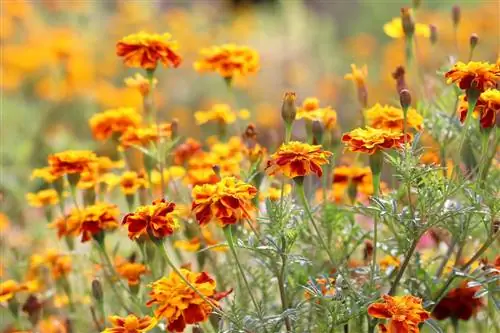
- Common names: velvet flower, velvet flower, Turkish carnation, dead flower
- Advantage: keeps nematodes out of the soil
- Sowing: from February to March on the windowsill
- Soil: medium-heavy and nutrient-rich with good permeability
- Location: love full sun places, also thrive in partial shade
- Requirements: ensure a consistent water supply
- Care: remove faded shoots regularly

